
Guild Info
Contact Us
Graphic Artists Guild
2248 Broadway #1341
New York, NY 10024
Tel: (212) 791-3400
January 2023 – The Guild published a “where we stand” statement on AI image generators defining the organization’s current stance on the technology. The statement acknowledged that while generative AI can be of value to visual artists, it raises serious questions about authorship, copyrightability, and ethics.
Guild President Liz DiFiore was interviewed in US Today on the Warhol v Goldsmith case before the Supreme Court, and the implications for graphic artists of a decision in favor of Warhol.
February 2023 – The Guild held a listening session on generative AI with Guild members.
The Guild filed comments in response to the Copyright Office’s Notice of Inquiry for their “Study on Non-Fungible Tokens and Related Intellectual Property Law Issues.” The Guild comments highlighted the potential NFTs provide for resale royalties and for a permanent record of authorship in the blockchain. The comments also pointed out the serious issues with copyright infringement, lack of safeguards for copyright holders, and confusion regarding intellectual property rights and smart contract terms which exist on the NFT marketplaces.
March 2023 – The Guild partnered with Concept Art Association, the Society of Illustrators, and the National Cartoonists Society in the AI/ML Media Advocacy Summit, a free, one-day conference on artificial intelligence generators. Guild Advocacy Liaison Rebecca Blake participated on the US panel discussion.
The Guild joined the Human Artistry Campaign, which asserts the primacy of human endeavor in the creative process, and seeks to support and protect the interests of creators in the face of the rapid advancement of AI generative technologies.
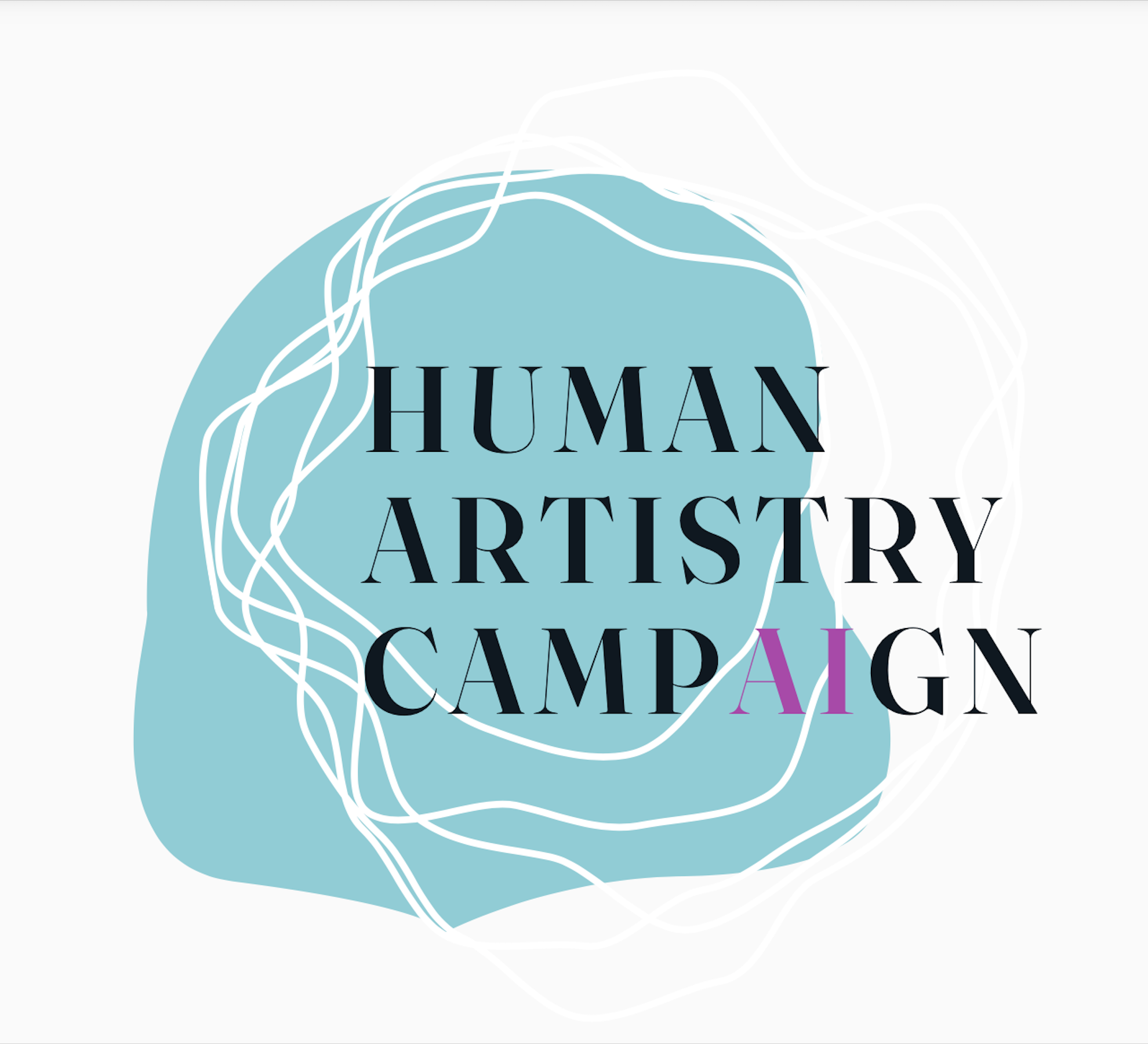
The Guild promoted the 2023 Artists Survey organized by Lisa Shaftel of Shaftel & Schmelzer. The survey asked graphic and fine artists how they register the copyrights to their works.
The Guild joined National Writers Union (NWU) and the Freelancers Union in sharing concerns with LA City Council staff on the LA Freelance Isn’t Free bill.
Guild board member Delanie West and Advocacy Liaison Rebecca Blake joined the Authors Guild, American Society of Collective Rights Licensing (ASCRL), Artists Rights Society (ARS), and the Society of Composers and Lyricists (SOCL) in visits with members of Congress and staff, and with staff from the Copyright Office, to express our united concerns the AI generative technology. The visits took place over three days.
April 2023 – Advocacy Liaison Rebecca Blake joined author and graphic novelist Carson Grubaugh and illustrator Tim O’Brien on the Professional Development panel at MoCCA Art Festival. The panel covered generative AI and artists, and was moderated by Viktor Koen, chair of the Comics and Illustration departments at SVA.
May 2023 – Guild Advocacy Liaison Rebecca Blake participated in a Copyright Office roundtable listening session on generative AI. The Office conducted a series of listening sessions in Spring 2023 by discipline. This listening session was focussed on the visual arts.
Rebecca Blake joined artist and AI critic Steven Zapata in a talk moderated by Professor Russ Altman at Stanford HAI symposium: Creativity in the Age of AI: Artist Perspectives on AI, Copyright, & Future of Work. They presented artists’ concerns with copyright infringement, job loss, and the ethical questions raised by AI image generators.
The Guild joined Romance Writers of America, Science Fiction and Fantasy Writers, Dramatists Guild, National Writers Union, Music Workers Alliance, Screenwriters Guild of America, and Society of Composers and Lyricists in signing on to a Creators Together letter authored by the Authors Guild. The letter was addressed to House and Senate Judiciary leadership and calls on Congress to pass legislation to permit individual creators to negotiate and act collectively, and to share information. US anti-trust law designed to prevent monopolistic activities applies to independent contractors as well as major corporations, essentially preventing independent workers from taking collective action.
The Guild applauded the Supreme Court decision in Warhol v Goldsmith, a case which has broad implications for graphic artists. The SCOTUS opinion rejected 7-2 the Warhol Foundation’s argument that the artist’s use of photographer Lynn Goldsmith’s portrait of Prince was “transformative”, and therefor fell under fair use. “tranformativeness.”
June 2023 – The Guild signed on to a letter authored by the Recording Industry of America (RIAA) in response to an Office of Science Technology and Policy (OSTP) request for comments on generative AI. The letter called for adequate record-keeping on the part of generative AI platforms; raised concerns the unauthorized use of likenesses, voices, and works on generative AI platforms; called for policy to be grounded in the protection of human authors; and supported the creation of licensing schemes.
July 2023 – The Guild joined a broad coalition of creators organizations in signing on to a letter drafted by the National Writers Union (NWU). The letter is a joint call for action on generative AI and sought to redress the damage being done by copying of creative work, without permission and or compensation, to develop generative artificial intelligence systems. The letter also addressed grave concerns with the EU exceptions to copyright enacted by the EU in 2019, which nowcreating a safe harbor in the EU for AI copyright infringement in violation of the Berne Convention.
Guild board member Delanie West and Advocacy Liaison Rebecca Blake participated in an all-day brainstorming session on generative AI with the Coalition of Visual Artists. The group discussed how best the organizations could address the copyright and labor issues raised by generative AI.
September 2023 – Guild Advocacy Liaison Rebecca Blake participated in the Copyright Society New York Chapter conference, Copyright + Technology. She represented the concerns of artists on a panel on generative AI, alongside Matthew Sag, Professor of Law, AI, and Data Science at Emory University School of Law, and Yacine Jernite, Machine Learning and Society Lead at Hugging Face.
October 2023 – Advocacy Liaison Rebecca Blake participated on the US Patents and Trademarks Office GIPA Seminar, speaking on a panel on the “Overview of the Visual Arts Industry: Impact of Legal, Technological, and Business Development.”
The Guild submitted comments in response to the Copyright Office’s Notice of Inquiry on Artificial Intelligence and Copyright. In our comments, the Guild asserted that the use of images for machine learning is not a fair use, that the use of an artists images to produce a fine-tuned model permitting the mimicry of that artist’s unique style damages artists in multiple ways, and that collective licensing is a viable means to ensure remuneration for the use of artwork in datasets.
January 2022 – The Guild submitted comments in response to the Copyright Offices Notice of Inquiry on Deferred Examination. Our comments supported the proposal of a deferred copyright examination process as a means to provide an affordable copyright registration option without burdening the Office with the need for an immediate examination of the registration. We also reiterated our support for a meaningful group registration option for visual artists other than photographers.
February 2022 – The Guild conferred with Adobe on their Creative Challenges which required artists to create work on speculation and received backlash from the community. With Guild guidance, Adobe issued a statement renouncing work on speculation and vowing to revise the requirements of their creative challenges.
March 2022 –The Guild joined the National Writers Union (NWU) and the Freelancers Union, in lobbying for the New York statewide Freelance Isn’t Free Act, S8369/A9368, introduced by New York State Senator Andrew Gounardes and Assemblymember Harry Bronson. The bill would provide vital protections for freelance workers and independent contracts who are dealing with non-payment and late payment of their invoices, as well as retaliatory harassment against those who seek fair remuneration. This landmark legislation was passed in New York City in 2017. The Guild continued a social media campaign and email outreach to NY-based graphic artists throughout the year.
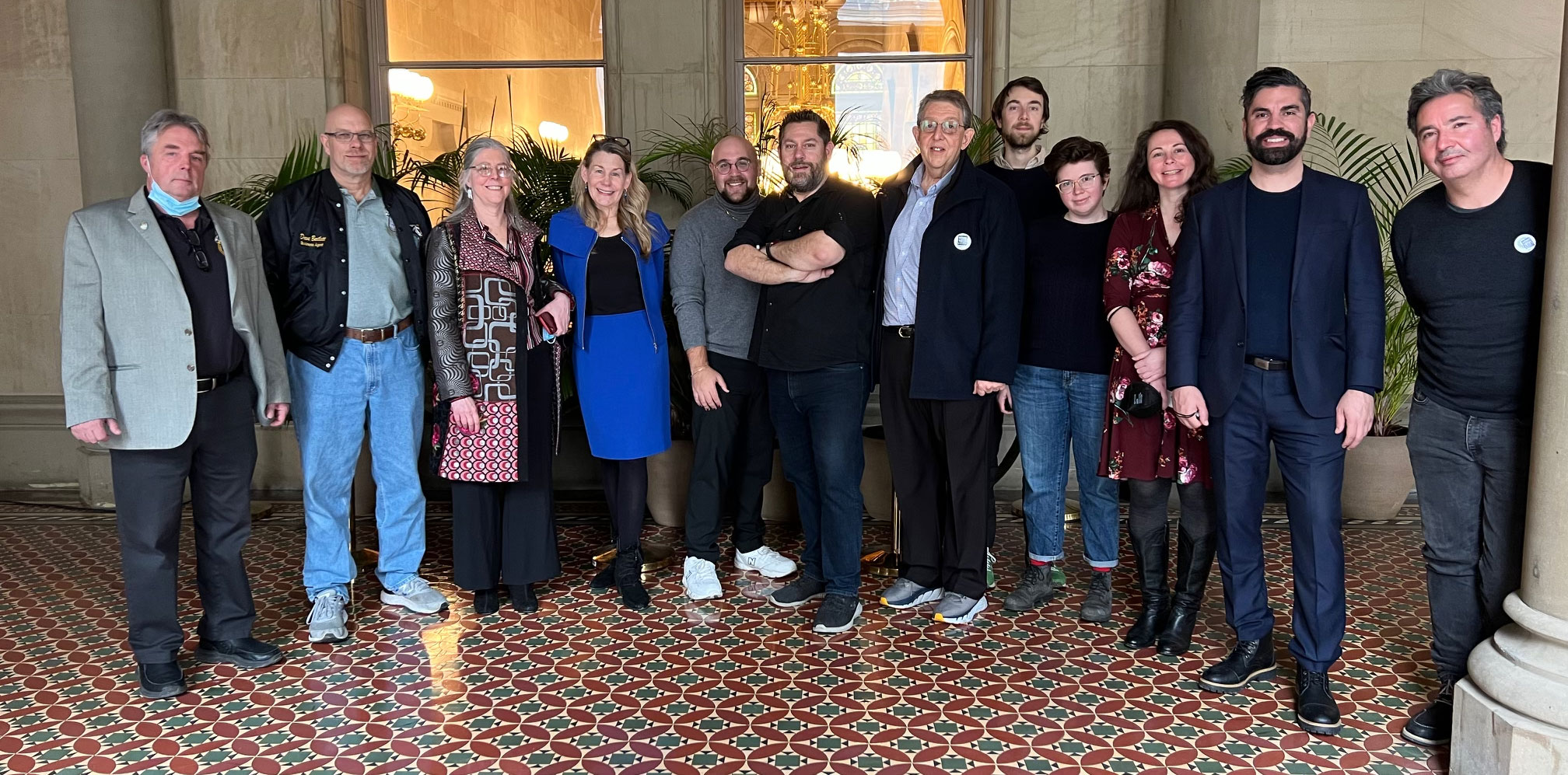
April 2022 – The Guild joined NWU and the Freelancers Union in meeting with members of the LA City Council to press for the LA Freelance Isn’t Free bill.
The Guild expressed support for the SMART Act by Senator Tillis, meant to reform the DMCA process by requiring the adoption of STMs (standard technical measures) by ISPs and OSPs.
May 2022 – The Guild Advocacy Committee developed a white paper, “Copyright Myths: Getting It Wrong About Protecting Your Rights.” The white paper addresses common myths about copyrights, as well as some lesser-known misconceptions, such as the use of Creative Commons licensing terms. The white paper was released to participants of a free webinar conducted by copyright lawyer and artist advocate Daniel Abraham.
The Guild produced a full-day virtual “Creators Conference”, covering copyright and legal issues faced by creators across all disciplines: writers, photographers, illustrators, designers, dramatists, songwriters, and composers. The event consisted of three panels: Working for free/paying to work: Contests, crowdsourcing, and publishing platforms; Contracts and terms: The unethical, the unenforceable, and the unavoidable; and Copyrights and rights grabs: How your work is taken, and how you can protect your rights. Moderators and panelists were booked from a number of creator advocacy organizations, including American Society of Media Photographers, American Photographic Artists, Dramatists Guild, National Writers Union, Authors Guild, International Council of Design, Freelancers Union, Music Workers Alliance, and Science Fiction and Fantasy Writers Association.
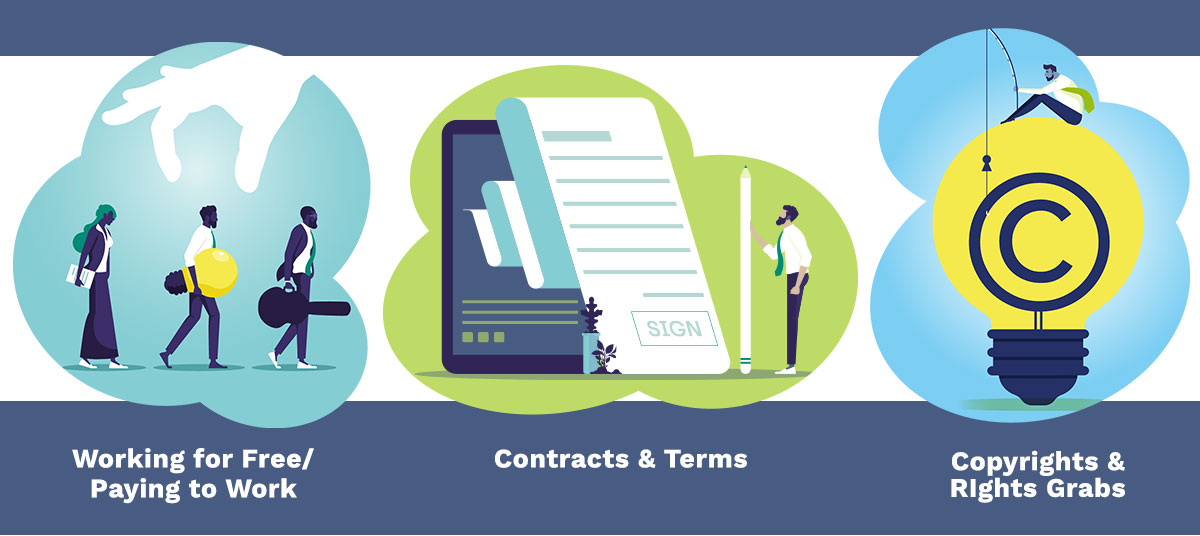
June 2022 – The Guild joined the Authors Guild and other creators’ organizations in lobbying for an amendment to labor law which would permit independent creative professionals to collectively bargain. We met with Representative Jamie Simpson and with staff from the offices of Representative Correa, Senator Coons, Senator Hirono, Senator Tillis, and Senator Leahy.
The Guild applauded passage of the New York State Freelance Isn’t Free Act, S8369/A9368. The bill went before Governor Kathy Hochul for signing.
July 2022 – The Guild signed on to an amicus brief drafted by NPPA and APA in Hunley v Instagram. The brief addressed the “server test”, a decision made in the Ninth Circuit (central California), which ruled that where an image is streamed from a platform or server, and not “fixed in the memory” of the infringers servers, the image has not been displayed (therefore an infringement has not occurred). This decision has been rejected by other jurisdictions. In this case, photographer Hunley sued Instagram, claiming they were secondarily responsible for infringements that occur via their embedding mechanism. Instagram moved to have the case dismissed, citing the server test decision made by the Ninth Circuit, which was granted.
August 2022 – The Guild, joined by ASCRL, submitted an amicus brief in Warhol v Goldsmith, authored by attorney Linda Joy Kattwinkel. The brief argued that the Warhol “Orange Prince” image is only moderately transformative, and as such fair use is outweighed by consideration of all four fair use factors.
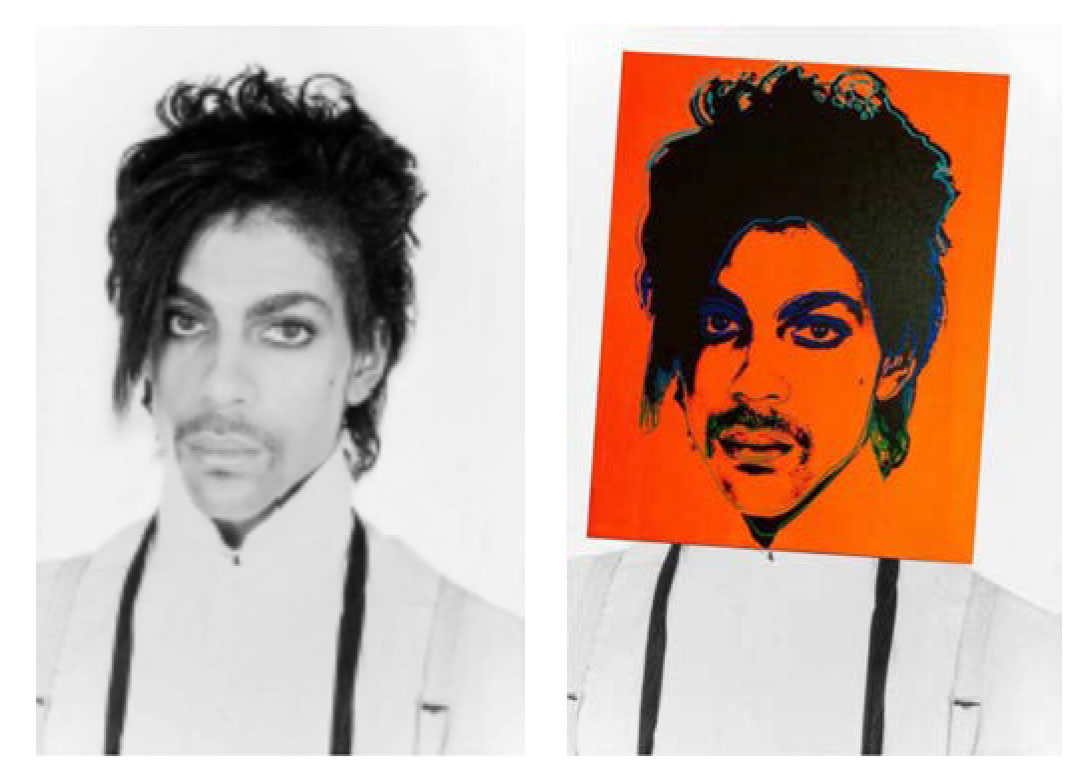
The Guild signed on to a second amicus brief in VHT v Zwillow, authored by NPPA.
October 2022 – Guild Excomm member Yanique DaCosta attended the International Council of Design (ICoD) board meeting in Kaunas, Lithuania.
The Guild submitted a statement of concern to the IFRRO General Assembly on AI image generators, and the detrimental impact this technology is having on graphic artists.
December 2022 – The Guild registered disappointment with Governor Kathy Hochul’s veto of the New York State Freelance Isn’t Free Act, which had passed by an overwhelming yes vote in June. The Guild vowed to keep working for this legislation in the new year.
January 2021 – The Graphic Artists Guild signed onto a letter drafted by SAG-AFTRA asking the Department of Labor to interpret PUA language so that mixed earners would be deemed eligible for those benefits under the CARES Act. We signed onto a second letter by SAG-AFTRA that went to state governors and legislators and asked for legislation to increase the state’s weekly base amount, and adopt a income reporting process that doesn’t harm part-time workers, entrepreneurs, and freelancers. In support of these initiatives, the Guild solicited feedback from graphic artists who didn’t qualify for pandemic unemployment benefits in their states.
Guild Advocacy Liaison Rebecca Blake gave a virtual presentation on “Advocacy for Artists” to Greenside Design Center students in Johannesburg, South Africa.

February 2021 – The Guild participated in discussions with the Coalition of Visual Artists on plans for copyright claims board (CCB) education and implementation.
Guild Advocacy Liaison Rebecca Blake was interviewed by Communication Arts on the Guild’s take on hiring homework, an unethical work-on-speculation practice in which individual interviewing for design positions are required to complete client work before being hired.
We signed on to an amicus brief in Desire v Manna, a case which questions whether multiple statutory damages can be awarded when there are multiple downstream infringers.
March 2021 – The Guild signed onto a letter drafted by the North American Nature Photography Association (NANPA), protesting a photography contest with an all-rights grab by the NJ Division of Fish and Wildlife.
April 2021 – The Guild protested McGraw-Hill’s policy of skimming 2% off the top of every “Small Supplier” invoice and initiated a campaign urging graphic artists to contact the publisher.
The Guild joined a group of creators organizations in meeting with Senator Lankford’s office hoping to make the more generous terms of the pandemic loan program retroactive, but unfortunately the program ran out of funding. We also participated in meetings organized by Professional Photographers of America (PPA) on extending pandemic relief.
The Guild signed on to an amicus brief submitted by American Society of Media Photographers (ASMP) in Unicolors v. H&M. In this case, Unicolors won against H&M for copyright infringement but lost when H&M appealed, claiming that an error Unicolors made on the copyright registration application invalidated the registration. The case was argued before the Supreme Court in October 2021.
May 2021 – The Guild joined an amicus brief in Fischer v Forrest, a case which dealt with Content Management Information (CMI) violations.
The Guild protested the Museum of Modern Art’s rights grab in their MoMA Photography Club social media campaign. MoMA claimed extensive, royalty-free, worldwide, perpetual, sublicensable, non-exclusive license to reuse any images posted with the #MoMAPhotoClub hashtag.
September 2021 – The Guild joined other visual artist associations in an amicus brief in Starz v MGM. MGM argued that the copyright infringement lawsuit brought by Starz, argued that Starz waited too long to bring the lawsuit. The case is crucial to copyright holders, since the law has routinely been interpreted to mean that rightsholders can bring a lawsuit within three years of the discovery of a copyright infringement, not within three years of the infringement occurring.
October 2021 – Guild Advocacy Liaison Rebecca Blake spoke on on real-world copyright and business issues for visual artists to graduate students at FIT.
December 2021 – The Guild signed on to an amicus brief submitted by American Society of Media Photographers (ASMP) in Unicolors v. H&M. In this case, Unicolors won against H&M for copyright infringement but lost when H&M appealed, claiming that an error Unicolors made on the copyright registration application invalidated the registration. The case was argued before the Supreme Court in October and a ruling is expected early next year.
January 2020 — The Guild signed on to an amicus brief in Gold Value v Sanctuary, a case which could have wide repercussions for copyright registrants. In this case, a copyright infringement case was dismissed and the infringer was awarded legal fees because of a harmless error in the copyright registration of the artwork.
The Guild continued to support the CASE Act, S. 1273/H.R. 2426 throughout 2020 via social media campaigns, articles, and meetings with Congressional staff.
March 2020 – The Guild submitted comments in response to the Copyright Office Notice of Inquiry on Online Publication. In the Guild’s response, we proposed that the definition of publication should be revised to include the public posting of a work online. The reasoning behind this is that works posted publicly are immediately vulnerable to rampant infringement, and that the distinction between published and unpublished has little meaning in an online environment.
To meet the COVID pandemic crisis, the Guild developed an online portal with links to resources, updated lists of grants and financial support for artists, and state-by-state health and business resources. The Guild also published a COVID work-from-home portal, with links to online webinars and meetups organized by the Guild and partner organizations, articles on managing work from home, links to creative resources, and a library of illustrations and cartoons created by Guild members.

Ongoing pandemic-related efforts throughout the year included a survey of Guild members on the economic impact of the pandemic, meetings with members of Congress to lobby for PPA relief for microbusinesses and freelancers, and coordinated efforts with other creators’ organizations in lobbying for support for households with mixed-earner income. We signed on to a letter authored by the Freelancers Union and addressed to House Majority Leader Nancy Pelosi, requesting the freelancers be included fairly in federal coronavirus relief packages. The Guild also published articles on how to apply for pandemic relief and PPA loans.
April 2020 — The Graphic Artists Guild joined a campaign spearheaded by the American Society of Media Photographers (ASMP) and National Press Photographers Association (NPPA) asking visual artists to make their Instagram accounts private and to post images explaining that the decision is in response to a court decision in Sinclair v Ziff Davis. In that case, the court dismissed a infringement lawsuit brought by photographer Stephanie Sinclair, who state that the online magazine Mashable infringed her copyright when they embedded one of her images that had been posted on Instagram. The purpose of the campaign is to pressure Instagram to enable users to prevent embedding of their images via Instagram’s API.
May 2020 — The Graphic Artists Guild issued a statement on Black lives and racial justice. The statement avowed that the Guild’s efforts in fighting for justice and equity for working graphic artists “are worth nothing if they are not equally accessible to Black designers and illustrators. Black lives matter – in their entirety.”
July 2020 — Guild members met with Congressional staffers to present their concerns with copyright small claims and support of the CASE Act: designer/illustrator Crisy Meschieri with staff from Senator Shelby’s office, designer James Bratten with staff from Senator Blunt’s office, and designer Dawn Mitchell with staff from Senator Mitchell’s office.
The Guild signed on to the Authors Guild comments to the Copyright Office in response to their Notice of Proposed Rulemaking on the recordation of notices of termination. The termination of a transfer of copyrights is vital for creators who sign all-rights buyout agreements. The Copyright Act permits authors and their heirs to terminate the grant of a transfer of copyrights or a license under certain circumstances. This permits authors and heirs, 35 years after the original grant, to avail themselves of the economic success of their work by regaining their copyrights.
October 2020 — Guild member designer Shir Warr met with staff from Senator Murphy’s office to express her support of the CASE Act. The Guild continued to publish case studies of copyright infringement of the works of graphic artists, and lobby for passage of the bill.
December 2020 – The Guild celebrated the passage of The CASE Act, The Copyright Alternative in Small Claims Enforcement Act of 2019.
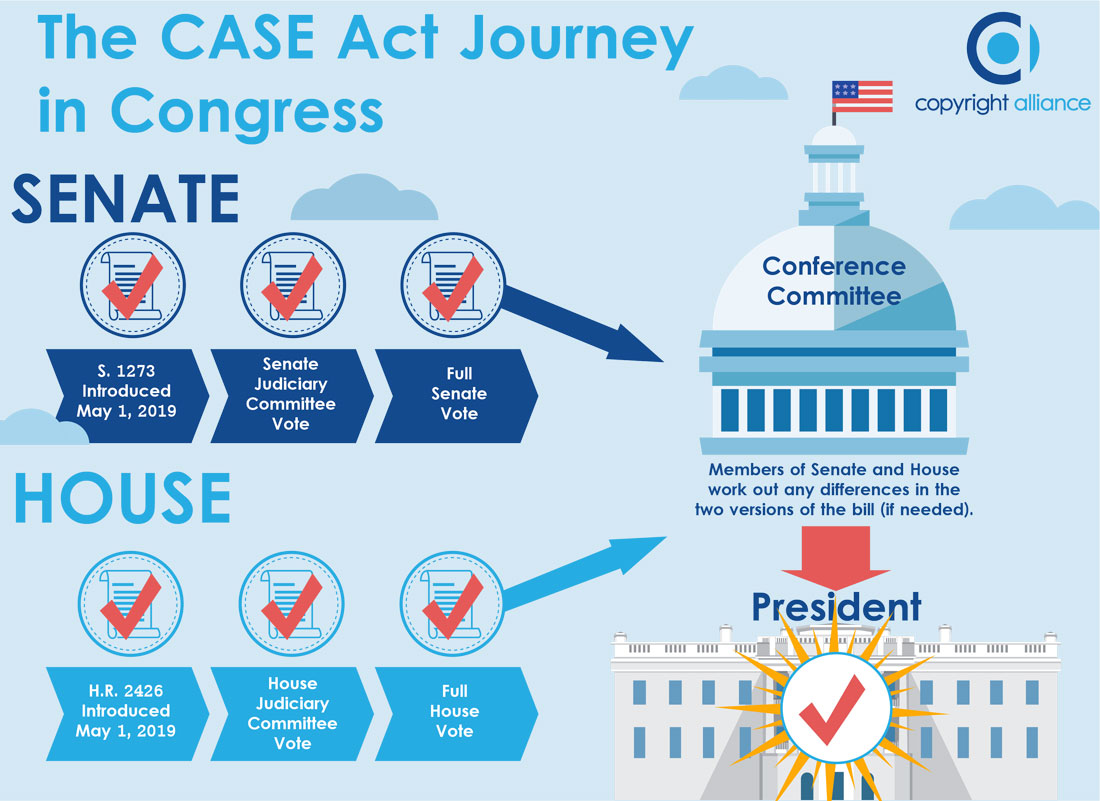
CASE Act progress infographic
January 2019 – The Graphic Artists Guild filed comments in response to the Copyright Office’s Notice of Inquiry on Copyright Modernization. In the comments, the Guild pointed out that the copyright registration system has been deficient in meeting the needs of graphic artists. Our recommendations included clarifying the definition of “publication” in an online environment, making a deferred or provisional registration option available, expanding the group registrations options currently available to only photographers to include all visual artists, integrating copyright registration into creators’ workflow via APIs, and eliminating a mandatory physical copy deposit requirement.
February 2019 – The Guild joined other creators’ organizations in an “Appeal from the Victims of Controlled Digital Lending (CDL),” organized by the National Writers Union. CDL is the scanning and distribution of entire books, including ones under copyright without license or the knowledge of teh copyright holders. The appeal points out that CDL is neither a digital equivalent of library lending, nor permissible under fair use.
April 2019 – Advocacy Liaison Rebecca Blake joined American Society of Media Photographers (ASMP) Executive Director Tom Kennedy in presenting on copyright small claims at an organized by the International Authors Forum. The event, an evening-long discussion of creators’ concerns, took place at the Grolier Club in New York City on the occasion of IAF’s annual General Assembly. The Guild also joined IAF and Artists Rights Society at a meeting with Register of Copyrights Karen Temple at the Copyright Office.
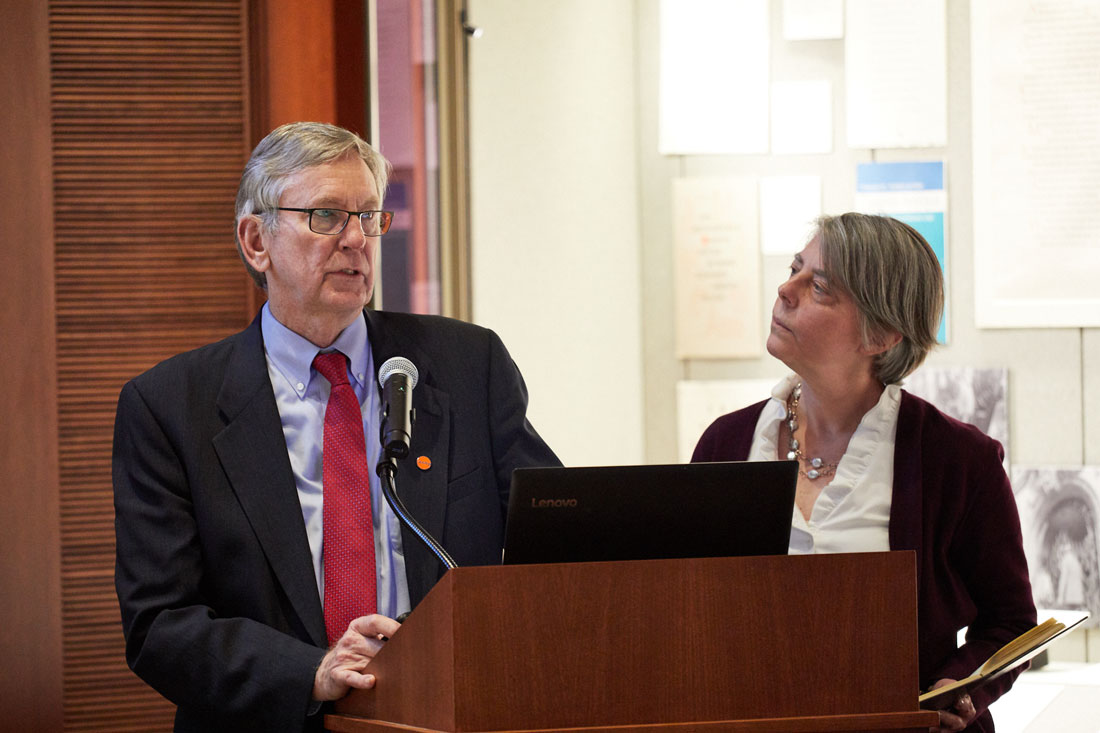
May 2019 – The Guild joined other creators’ organizations and the Copyright Alliance for lobbying in support of the CASE Act (H.R. 2426/S. 1273) on the day he legislation was introduced into both the House and the Senate. The Guild engaged in significant lobbying efforts in support of the legislation throughout 2019, developing website resources on the legislation, drafting messages for members to send to Congress, and developing case histories of graphic artists who have been harmed by copyright infringement.
June 2019 – The Guild responded to a request from the Copyright Office for stakeholder feedback on the the third edition of the Compendium. In our comments, we raised objections to the Office’s proposal that, when an error arises in a registration, the registration specialist has the discretion to either contact a the individual registering the copyright, or to reject the registration outright.
July 2019 – Guild board members Dawn Mitchell, Yanique DaCosta, Liz DiFiore, and Rebecca Blake joined the Copyright Alliance and a broad coalition of creators’ organizations, representatives from the American Bar Association, and the Chambers of Commerce for a day of lobbying on Capitol Hill. The trip culminated in the Senate Judiciary Committee mark-up of S. 1273 and the passage of the bill out of committee.

Joining creators organizations in thanking Senator Kennedy for introducing the CASE Act
September 2019 – The Guild joined Professional Photographers of America (PPA) for Congressional visits in support of the CASE Act shortly after the House version of the bill, H. 2426, passed the House Judiciary Committee. Guild illustrators Ed Shems and Liz DiFiore developed illustrations and hand-lettered artwork to use in social media campaigns in support of the legislation.
The Guild signed on to an amicus brief in Allen v Cooper, authored by ASMP and National Press Photographers Association (NPPA). The lawsuit addresses the issue of copyrights and sovereign immunity, specifically whether state actors can be sued for copyright infringement. The Supreme Court is scheduled to hear the case in 2020.
October 2019 – The Guild attended the IFRRO General Assembly in Edinburgh, Scotland, and joined NPPA and ASMP in giving an update on advocacy for visual artists in the United States to the visual artists workgroup.
November 2019 – The Guild participated in roundtable discussions on copyright modernization conducted by Senator Tillis’ office. The discussions continued on a monthly basis through early 2020.
Guild Excomm member Yanique DaCosta attended the ico-D General Assembly and Platform Meeting in Vancouver, Canada.
December 2019 — Guild member and designer Todd LeMieux designed an billboard and social media graphics targeting Sen. Ron Wyden for his hold on the CASE Act. The billboard was funded by ASMP and was installed outside Sen. Wyden’s Seattle, WA office.
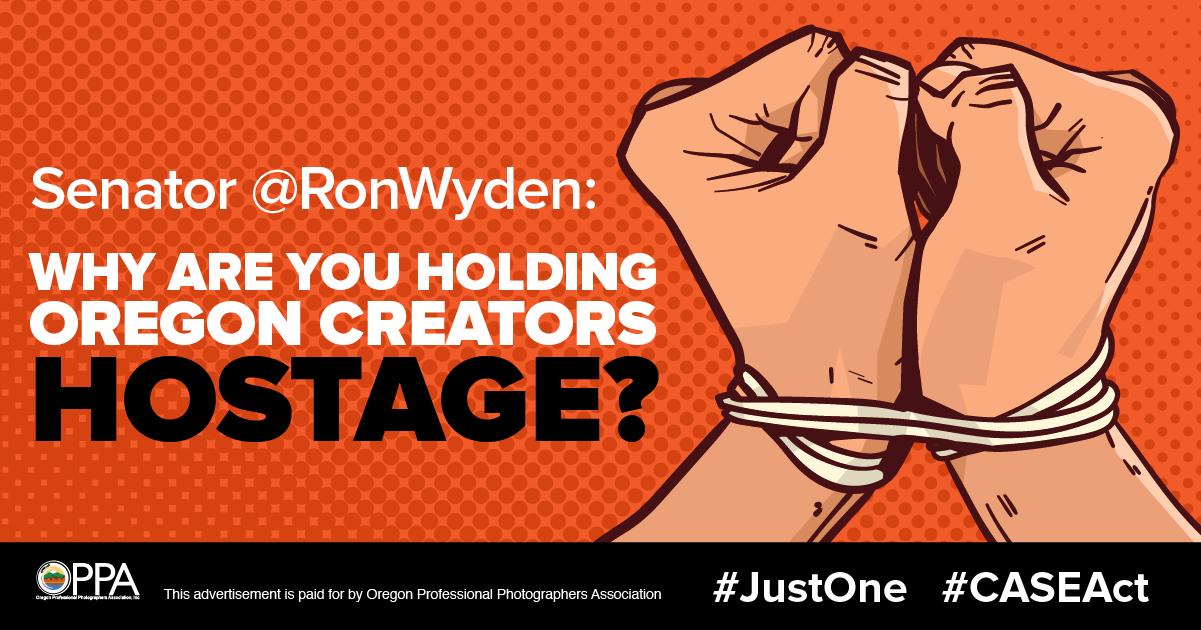
January 2018 – The Guild joined other creators organizations in a “Day of Action” in support of the CASE Act, asking people to ask their representatives to co-sponsor H.R. 2945, the CASE Act, establishing a copyright small claims tribunal. Guild member and cartoonist William Morse created cartoons to use in social media campaigns, illustrating the issue artists have in enforcing their copyrights.

CASE Act cartoon © William P. Morse
Guild member, marine illustrator Pieter Folkens, participated in a panel discussion on copyright issues hosted at George Mason University in Arlington, VA.
The Guild signed on to an amicus brief authored by Digital Media Licensing Association (DMLA) in VHT v Zwillow. VHT, a photography studio, was awarded $8.3 million in their lawsuit brought against online realtor Zwillow. The jury verdict for most of the images was overturned, cutting the award to $4.05 million. VHT is appealed that ruling, and in that appeal, Zwillow argued that the jury should not have awarded statutory damages for each of the infringed images, but rather a single award for all the infringements since the photos were registered under the group registration for databases option. The amicus brief argues that each work has an independent economic value, and that the form of registration (as a group, etc.) should not be considered.
April 2018 – The Guild joined the Coalition of Visual Artists associations in Congressional visits in support of the CASE Act. The visits were preceded by a social media campaign, with daily graphics counting down to the lobbying day.

The Guild conducted a campaign urging graphic artists to contact their representatives and ask them to support of H.R. 1695. The bill sought to make the Register of Copyrights, currently appointed by the Librarian of Congress, a presidential appointee with a 10-year term with the advice and consent of the Senate.
May 2018 – The Guild met with members of the advocacy arm of the Small Business Administration to discuss concerns we have with intellectual property protection for creative professionals.
Guild Advocacy Liaison Rebecca Blake participated in a panel discussion, Doing Business Online, put on by the New York Foundation for the Arts and the New York City Bar Association’s Art Law committee. The panel covered legal and business issues faced by artists working online.
June 2018 – The Guild continued with publicity efforts in support of the CASE Act. Guild board members Todd LeMieux and Dawn Mitchell educated attendees of Creative Pro at the Guild booth, generating interest in the issue.
July 2018 – Guild members Ed Shems and Haydn Adams represented the Guild at ICON, the Illustration Conference. While there, they distributed educational materials on copyright small claims and the CASE Act, and solicited support for the bill from attending illustrators.
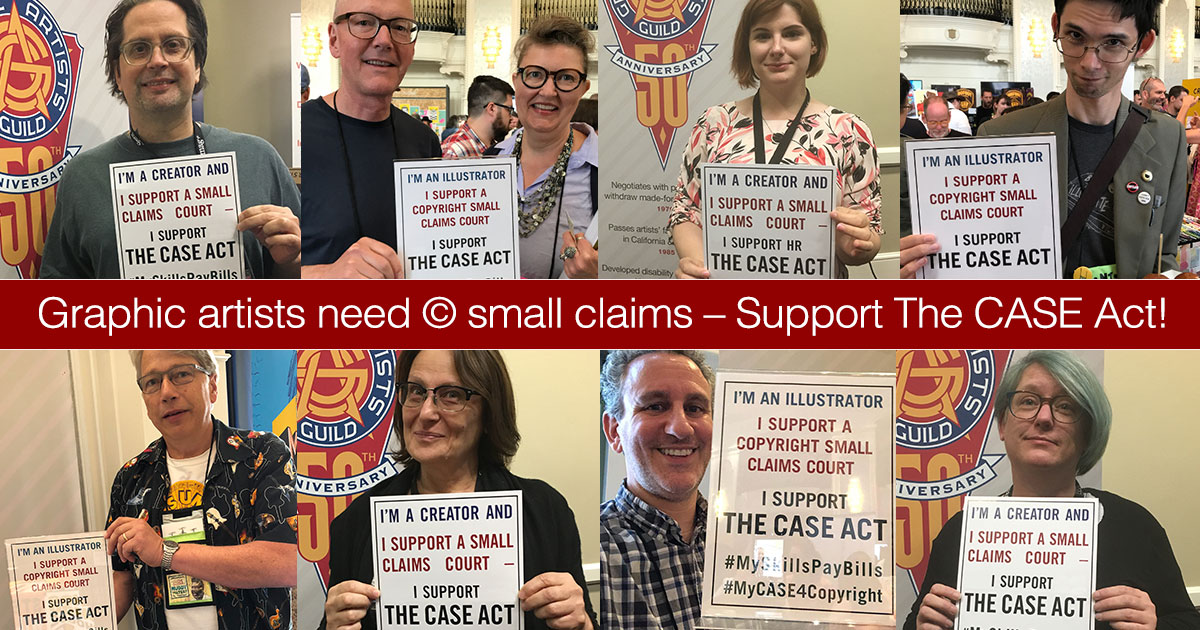
September 2018 – The Guild submitted comment to the Copyright Office in response to their Notice of Proposed Rulemaking on Copyright Registration Fees. In our comments, the Guild pointed out that raising registration fees as proposed by the Office as wages for visual artists remain stagnant will deter copyright registration.
The Guild joined an amicus brief authored by the Authors Guild in Fourth Estate Public Benefit Corporation v. Wall-Street.com, LLC. The amicus brief pointed out that the rampant, immediate infringement of copyrighted works continues to balloon even as registration processing times increase.
Guild Excomm member Yanique DaCosta represented the Graphic Artists Guild at the ico-D General Assembly in Beijing, China. She gave a presentation on copyright small claims in the United States, and the Guild’s campaign to support legislation establishing a small claims tribunal (the CASE Act).
October 2018 – The Guild attended the IFRRO General Assembly in Athens, Greece, joining American Society of Media Photographers (ASMP) and National Press Photographers Association (NPPA) in presenting on advocacy efforts by US visual artist associations.
The Guild signed on to an amicus brief in Brammer v Violent Hues, authored by NPPA and ASMP. The court finding of fair use in the case of photographer Russell Brammer versus Violent Hues Productions drew condemnation from artist advocates. The worry was that the decision created a precedent that would define almost any use of copyrighted material as fair use, effectively gutting copyright protections for creators.
January 2017 — The Graphic Artists Guild with the Coalition of Visual Artists signed on to a comment letter in response to a notice of proposed rulemaking issued by the Copyright Office asking for feedback on proposed changes to the group registration of photographs.
The Guild joined the Coalition of Visual Artists in submitting a response to the policy proposal for reform of the Copyright Office, drafted by House Judiciary Chair Bob Goodlatte (R – VA) and Ranking Member John Conyers (D – MI). The proposal called for greater autonomy for the Copyright Office, the creation of an advisory committees, IT modernization, and creation of a copyright small claims tribunal. The response extended an in-depth discussion of a copyright small claims tribunal.
The Guild called upon creators to respond to the Librarian of Congress’ survey on the Register of Copyrights, asking them to let the Librarian know the next Register should have the support of the creative community.
March 2017 — The Graphic Artists Guild with the Coalition of Visual Artists signed on to a comment letter in response to a notice of inquiry issued by the Copyright Office on moral rights.
April 2017 — The Graphic Artists Guild called upon visual artists to support H.R. 1695. The bill seeks to make the Register of Copyrights, currently appointed by the Librarian of Congress, a presidential appointee with a 10-year term with the advice and consent of the Senate. The Guild has long supported giving the Copyright Office greater autonomy and modernizing the Office
May 2017 — The Graphic Artists Guild applauded the introduction of “The Register of Copyrights Selection and Accountability Act” into the Senate as S.1010 on May 2nd.
July 2017 — On July 20th, the Guild joined members of the Coalition of Visual Artists for meetings with Congressional staff on key copyright issues. The meeting is part of the Guild’s ongoing advocacy efforts on copyright reform on behalf of graphic artists.
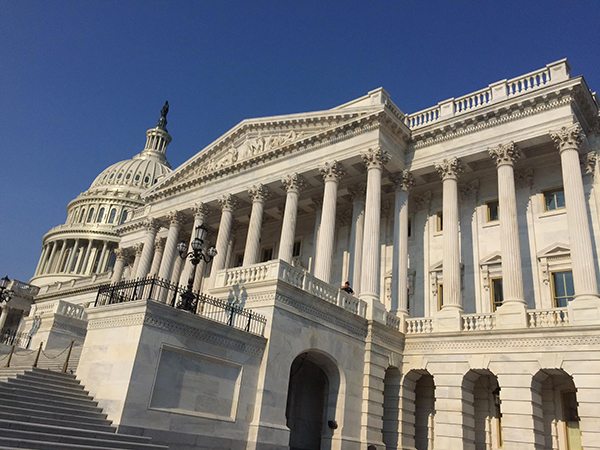
October 2017 — Guild Advocacy Liaison Rebecca Blake participated in ico-D’s General Assembly in Montreal, Canada and ran a half-day session on National Design Policy at their Professional Platform Meeting. She also organized a panel on the topic at the World Design Summit in Montreal.

November 2017 — The Guild attended the IFRRO World Congress on reprographic reproduction rights in Tokyo, Japan.
March 2016 – The Guild conducted a survey of visual artists on the efficacy of the DMCA Takedown Notice procedure. The survey results were used to inform a comment letter put out by the Coalition of Visual Artist Associations, in response to a public study being conducted by the Copyright Office.
The Guild joined the Coalition of Visual Artists in drafting a white paper on the key components of a copyright small claims tribunal. The white paper advocates for the creation of a small claims tribunal within the U.S. Copyright Office.
May 2016 – Guild Advocacy Liaison Lisa Shaftel participated in roundtables on the DMCA process conducted by the Copyright Office, representing the concerns of graphic artists.
August 2016 — Guild Excomm member Rebecca Blake coordinated a presentation on national design policies for ico-D’s Professional Platform Meeting in Pasadena, CA.
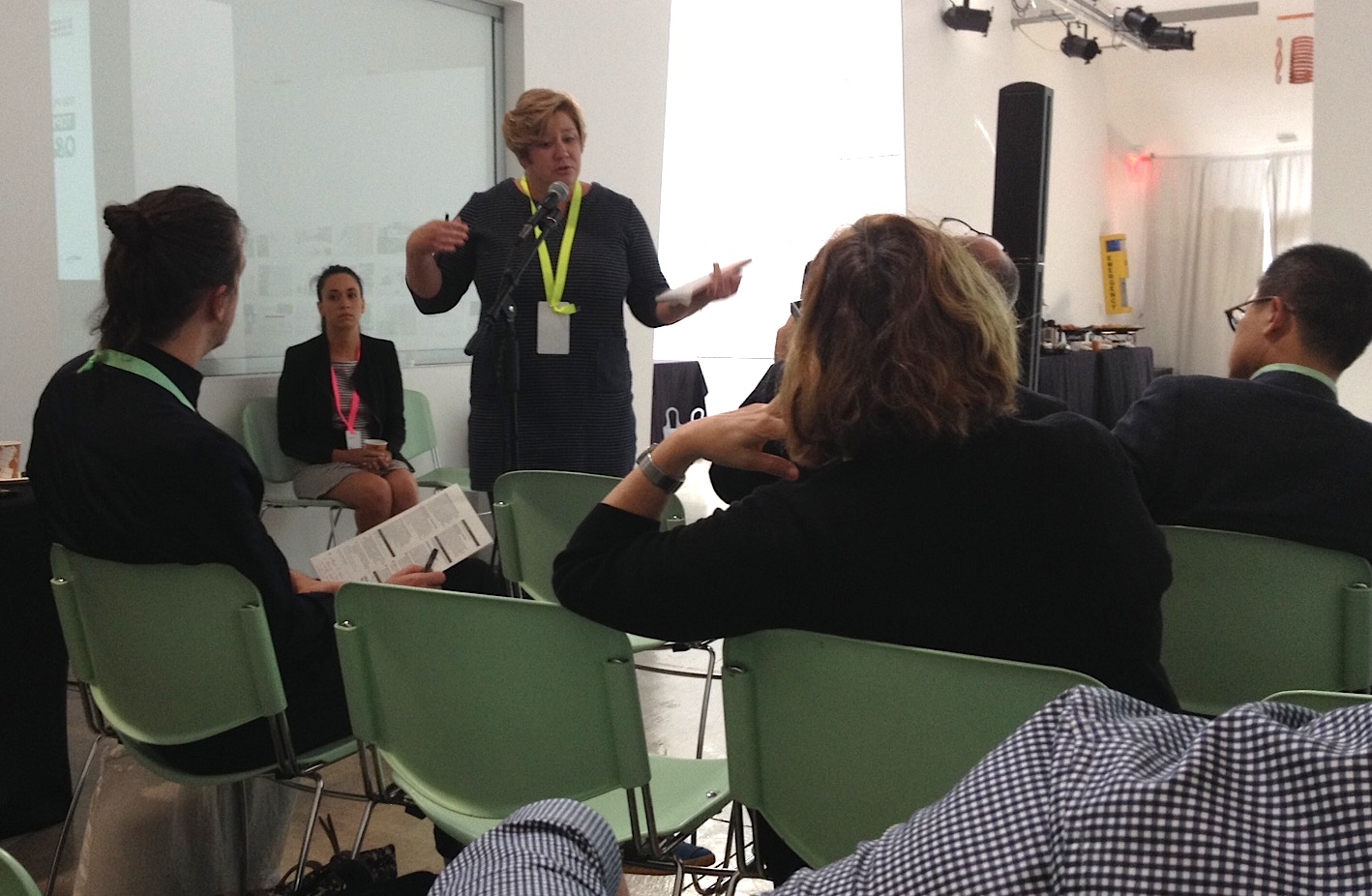
December 2016 —The Guild joined members of the Coalition of Visual Artists for meetings with Congressional staff on key copyright issues. The meeting is part of the Guild’s ongoing advocacy efforts on copyright reform on behalf of graphic artists.
The Guild called on graphic artists to respond to the Librarian of Congress’s public survey on the next Register of Copyrights. The Guild asked visual artist and all who rely on a strong copyright system to let the Library know that we need a Register who understands the value of copyright, recognizes the need for the Office to be modernized, and has the support of the creative community.
March 2015: The Guild joined CreativeFuture, a coalition of over 350 companies and organizations that seeks to address piracy. The coalition has three primary initiatives: mobilizing the creative community to speak up about the harm caused by piracy; advocating for policies which will staunch the flow of funds to pirate site operators; and educating youth about the cultural, ethical, and economic value of creative ownership.
The Guild joined the Coalition of Visual Artists Associations in protesting the College Art Association’s “Code of Best Practices in Fair Use for the Visual Arts.” The letter contested a major conclusion of the study, that “copyright acts primarily as a barrier, encouraging self-censorship; and that artists are in an adversarial relationship with the marketplace.” The letter points out that artists only seek fair compensation to their work, and that the study fails to educate its audience on options for licensing work.
May 2015: The Guild sent a letter to the Small Business Administration protesting the federal agency’s crowd-sourced “Seed for the Future” logo design contest. The Guild’s letter pointed out the irony of the Small Business Administration promoting innovative small businesses, by underpaying small business owners (independent designers and illustrators) for speculative design work through crowdsourcing.
July 2015 — The Guild filed comments on the Copyright Office’s Notice of Inquiry, titled “Copyright Protection for Certain Visual Works.” The inquiry sought commentary from authors of visual works and licensees on five specific questions:
October 2015 — Guild board member Rebecca Blake attended the International Council of Design’s (ico-D, formerly icograda) General Assembly in Gwangju, South Korea and participated in ico-D’s Professional Platform Meeting roundtable on National Design Policy.
November 2015 — Guild Advocacy Liaison Lisa Shaftel participated in the 2015 Creative Rights Caucus for the House Judiciary Committee in Washington, DC. The Creative Rights Caucus is a bi-partisan legislative “listening” committee co-Chaired by Representative Judy Chu (D-CA) and Representative Doug Collins (R-GA). The event was organized by the Professional Photographers of America [PPA]. The Congressional Creative Rights Caucus is dedicated to protecting the rights of content creators.
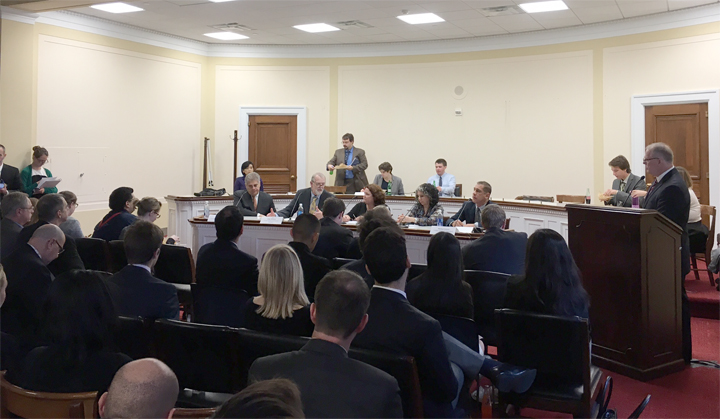
2015 Creative Rights Caucus, Rayburn House Office Building, Washington, DC
11/3/2015
Committee Co-Chaired by Rep. Judy Chu (D-CA) and Rep. Doug Collings (R-GA)
Hosted by David Trust and Professional Photographers of America
Panelists L to R: Denis Reggie (photog), John Schmelzer (illustrator), Mary Fisk Taylor (photog), Lisa Shaftel (graphic artist), Michael Grecco (photog), David Trust moderates at the podium (PPA)
Rep. Judy Chu is seated behind Denis Reggie
March 2014 – The Guild participated in a US Copyright Office Roundtable discussion on “Orphan Works and Mass Digitization.”
The Guild filed a comment Letter to the US Copyright Office Notice of Inquiry on “Strategic Plan for Recordation of Documents.”
The Guild participated in US Copyright Office Roundtables on Reengineering of Recordation of Documents.
May 2014: The Guild submitted a Comment Letter to the US Copyright Office Notice of Inquiry about “Technological Upgrades to Registration and Recordation Functions.”
June 2014: Guild member illustrator Ed Shems testified at the House Judiciary Committee hearing on the First Sale Doctrine.
Ed Shems also participated in a US Patent & Trademark Office Roundtable Discussion on “Remixes, First Sale, and Statutory Damages” at Harvard University School of Law.
Transcript available here
Webcast viewable online
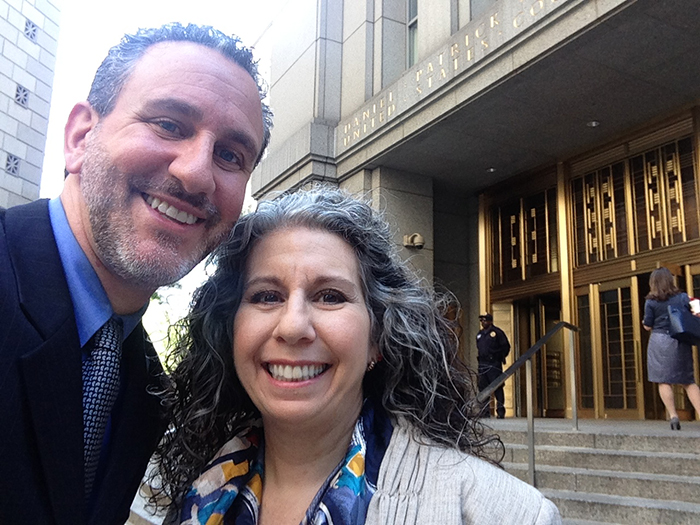
Guild member Ed Shems (with Advocacy Liaison Lisa Shaftel) before testifying on the first sale doctrine
Guild joined the National Writers Union, the Science Fiction Fantasy Writers of America, and the Society of Children’s Book Authors and Writers in signing on to an amicus brief in support of “Superman” creators, Siegel and Schuster, and artist Jack Kirby. The families of Siegel and Shuster, and of Kirby, petitioned the US Supreme Court hear their appeals of two Circuit Court decisions which rejected their attempts to regain the copyrights.
October 2014: Guild Advocacy Liaison Lisa Shaftel participated in the Kernochan Center for Law, Media and the Arts Symposium, “Creation is Not Its Own Reward: Making Copyright Work for Authors and Performers.”
Lisa Shaftel participated in a roundtable discussion on United Nations Human Rights Council Special Rapporteur Farida Shaheed’s report, “Copyright Policy And The Right To Science And Culture.”
Guild Executive Director Tricia McKiernan and Excomm member Rebecca Blake participated in icograda’s Professional Platform Meeting in New York City. Tricia McKiernan gave a presentation on speculative practices. Rebecca Blake was invited to head the organization’s National Design Policy workgroup.

The 14th Edition of Pricing & Ethical Guidelines was published and distributed to members.
Guild Executive Director Tricia McKiernan and Excomm member Rebecca Blake attended icograda’s 2013 General Assembly Meeting in Montreal, Canada. Rebecca Blake gave a presentation on the Guild’s organizational structure and advocacy efforts in the United States. She was also elected the organization’s first-ever Audit Committee.
January 2012: The Advocacy Committee submitted two (2) comment letters to the U.S. Copyright Office in response to both first and second Notice of Inquiry regarding Remedies for Small Copyright Claims. The Copyright Office was studying creating an alternative dispute resolution for small-value copyright infringement claims, separate from the current Federal District Court procedure, intending this to be a lower cost and more accessible system for rights holders to seek legal remedy for infringements, resulting in smaller monetary damages or simply injunction against infringing users, which rights holders cannot realistically pursue in Federal Court.
In support of the Guild’s first comment letter for a small claims copyright system, the Guild conducted an online survey, open to all authors and creators, regarding their experiences with infringement of their works and the proposal to create an alternative dispute resolution for small-value copyright infringement claims by the U.S. Copyright Office.
May 2012: The Guild conducted an online survey open to all artists regarding the proposed increase of registration and other filing fees by the U.S. Copyright Office, and subsequently submitted a Comment Letter to the U.S. Copyright Office in response to the Notice of Inquiry regarding the 2012 Proposed Fee Increases.
October 2012: Former National President John Schmelzer and Advocacy Committee member Lisa Shaftel attended the 2012 IFRRO Annual General Meeting in Buenos Aires, Argentina, as Guild representatives.
November, 2012: On November 15 & 16, the Guild participated in the Copyright Office roundtable hearings on Remedies for Small Copyright Claims, in New York City.
The Advocacy Committee submitted a comment letter to the U.S. Copyright Office in response to the Notice of Inquiry regarding Resale Royalty Rights.
The Guild met on an ad hoc basis with other visual creator’s organizations, including ASMP, PPA, PACA, National Press Photographers Association (NPPA), NANPA and American Photographic Artists (APA), to discuss copyright and legislative issues. Beginning with the Copyright Office study about alternative dispute resolutions for small-value copyright infringement claims, the group sought to make recommendations, regarding the protection of the intellectual property rights of visual creators, to the Copyright Office, Congressional offices, and other pertinent groups. This group of visual artists organizations later became known as the Coalition of Visual Artists.
During the 2012 Congressional Session, the Guild continued to be actively involved throughout the country with the Copyright Alliance, representing visual creators’ copyright and professional concerns.
The Guild established professional webinars on timely business and industry topics as part of an ongoing educational effort. Webinars are available to members as part of their membership and archived in the members-only section of the Guild’s web site for playback.
The Guild made available a series of downloadable PDF booklets on topics such as essential business practices and starting your own communications design business.
A letter-writing campaign to the Senate Committee on Finance was launched in support of S.3578—The Small Business Paperwork Mandate Elimination Act, introduced by Senator Mike Johanns (R-NE). The Act would repeal IRS Notice 2010-51 included in the Patient Protection and Affordable Care Act of 2010 (the health care bill). This bill was passed and IRS Notice 2010-51 repealed.
The Guild began a mentorship with JAMCOPY, the Jamaican Copyright Licensing Agency. From April 23 to 29, 2011, National Advocacy Committee Chair Lisa Shaftel and Executive Committee Member Todd LeMieux participated in Jamaica Intellectual Property Week 2011, in Kingston, Jamaica, as representatives of the Guild.
The Guild continued to be actively involved with the Copyright Alliance, representing visual creators’ copyright and professional concerns throughout the country during the 2011 Congressional session.
The Guild took a lead role in alerting artists to possible logo infringement by the web site, LogoGarden.com.
The Guild sent an open letter to the Obama for America campaign, expressing outrage that the reelection campaign solicited work on speculation from artists for a poster contest supporting the Obama jobs bill. Worse, the contest rules granted the Obama for America campaign an unrestricted, unpaid, irrevocable license to use all submissions.
The Guild sent an open letter to the Convention Committee of the Democratic National Committee 2012 to protest their crowd-sourcing poster contest for the 2012 Presidential Convention. The poster contest included many of the same rules and terms as the Obama for America poster contest.
The Guild coordinated a letter-writing campaign in support of S. 978, the Commercial Felony Streaming Act, a bill to amend current copyright law to include new technology, specifically the illegal streaming of copyrighted motion pictures over the Internet.
The Guild supported The Artist-Museum Partnership Act of 2011 which seeks to amend the U.S. Internal Revenue Code of 1986 “to provide that a deduction equal to fair market value shall be allowed for charitable contributions of literary, musical, artistic, or scholarly compositions created by the donor.”
The Guild supported the bipartisan legislation, S. 968 — Preventing Real Online Threats to Economic Creativity and Theft of Intellectual Property Act of 2011. This legislation would have given Federal law enforcement more tools to go after rogue web sites internationally that facilitate copyright infringement, sell unauthorized/infringing copyrighted works, and traffic in counterfeit consumer goods, including pharmaceuticals and knock-offs.
The Guild issued a public statement withdrawing its support of H.R. 3261—Stop Online Piracy Act [SOPA], the House version of S. 968 — The Protect IP Act, after receiving numerous complaints about SOPA from within the industry.
Guild Excomm member Rebecca Blake attended the icograda General Assembly in Taipei, Taiwan.
The Graphic Artists Guild joined several other visual arts rights holders’ trade groups and prominent individual photographers in filing objections to the $125 million class action settlement with Google Books for copyright infringement.
The American Society of Media Photographers (ASMP), joined by the Graphic Artists Guild, the Picture Archive Council of America, and the North American Nature Photography Association, filed a statement for the U.S. House of Representatives Judiciary Committee hearing on “Competition and Commerce in Digital Books.” The statement, which has been added to the hearing record, represents the interests of thousands in the visual artist community.
Guild Executive Director Tricia McKiernan briefed the Senate Small Business Committee about the importance of copyright to the livelihood of graphic artists as part of a panel of Copyright Alliance members.
Coinciding with the 2009 IFRRO Annual General Meeting in Oslo, Norway, an International Authors Forum was held in Oslo on Tuesday, October 20. The meeting focused on media concentration, authors’ rights, and contracts — the same issues the Graphic Artists Guild has promoted in the United States since its inception in 1967 and supported by the Guild via its presence at the meeting.
Guild member Chad Cameron was part of a delegation of emerging artists in The Copyright Alliance’s grassroots network of creators who delivered to the White House a letter signed by more than 11,000 artists nationwide asking President Obama and Vice President Biden to pursue policies supportive of artists’ rights.
The Advocacy Committee submitted a comment letter on behalf of the Guild to the U.S. Copyright Office on Notice of Proposed Rulemaking regarding Mandatory Deposit of Published Electronic Works Available Only On-line.
The 13th Edition of The Graphic Artists Guild Handbook: Pricing & Ethical Guidelines was published and distributed to members.
After much research and input by Advocacy Committee members, a comment letter on behalf of the Guild regarding the Joint Strategic Plan of the PRO-IP Act of 2008 was sent to Ms. Victoria A. Espinel, United States Intellectual Property Enforcement Coordinator.
The Advocacy Committee sent a comment letter on behalf of the Guild supporting the repeal of the 1099 provision in IRS Notice 2010-51, which was submitted to the Internal Revenue Service. (This provision was subsequently repealed April 5, 2011.)
At the request of Access Copyright of Canada, the Guild submitted a comment letter composed by the Advocacy Committee, regarding Canada’s international obligations concerning Canadian Bill C-32, The Copyright Modernization Act, to The Honorable James Moore, Minister of Canadian Heritage and Official Languages. The letter expressed concern about some of the exceptions contained in the proposed bill and the negative impact on rights holders’ revenue.
The Guild, the American Society of Media Photographers (ASMP), Professional Photographers of America (PPA), Digital Media Licensing Association (PACA), and North American Nature Photography Association (NANPA) teamed together, along with individual visual artists, to file a class action lawsuit for copyright infringement against Google, Inc. in the U.S. District Court for the Southern District of New York, in reaction to the Authors Guild v. Google settlement. The AG/AAP settlement had omitted all royalties due rights holders of visual works included in the books and other publications already scanned and future digitization of printed material.
In October, former National Guild President John Schmelzer, and Advocacy Chair Lisa Shaftel attended Guild representatives the 2010 IFRRO Annual General Meeting in Boston, Massachusetts.
Guild ExComm member Rebecca Blake represented the Guild at the icograda General Assembly in Beijing, China.
The Graphic Artists Guild worked with the Guild lobbyist to coordinate with the Copyright Office and Congressional staff regarding proposed orphan works legislation. Also representing the National Textile Association, the American Craft & Hobby Association, and George Little Management, these organizations collaborated, along with the American Society of Media Photographers (ASMP) and the Professional Photographers of America (PPA).
The Guild participated in a roundtable discussion in Washington, DC with the Copyright Office, regarding revision of the section of U.S. Copyright Law on “Compilations” and provisions for counting of damages for infringing use of works registered as compilations. Testimony was submitted on behalf of illustrators and other graphic artists.
The Graphic Artists Guild & ASMP filed an amicus curiae in support of the owner of the Perfect 10 web site in his appeal of the lower court’s denial of his copyright infringement
suit against Google.
Guild President John Schmelzer and Advocacy Chairperson Lisa Shaftel attended the 2008 Annual General Meeting of the International Federation of Reproduction Rights Organisations (IFRRO) in Jamaica, as Guild representatives.
The Graphic Artists Guild joined the Authors Guild in warning members about the all-rights, print-on-demand contracts being forced on authors and illustrators by Simon and Schuster.
The Guild joined the Copyright Alliance and participated in its Copyright Expo.
The 12th Edition of Pricing and Ethical Guidelines was published and distributed to members.
Representatives of the Executive Committee of the Graphic Artists Guild, Executive Director Tricia McKiernan and ExCom member Rebecca Blake, attended the World Design Congress in Havana, Cuba, to accept the Guild’s permanent membership in icograda.
The “Orphan Works” issue continued as a major issue for visual artists with the introduction of a Congressional bill in the House of Representatives. The Guild joined forces with other visual artists’ organizations to fight the sections of the bill that would be detrimental to the livelihood of all visual artists. (See Orphan Works: A Recent Legislative History for more information.)
The Guild supported photographer Thomas Dallal in his copyright infringement lawsuit against The New York Times. The Guild, in conjunction with the American Society of Media Photographers (ASMP), submitted an amicus brief in support of Dallal’s appeal of an earlier court decision in favor of The New York Times. The Second Circuit Court of Appeals vacated the earlier decision and the judges ordered The New York Times to negotiate a settlement payment for usage fees of over 1,000 images created by Tom Dallal.
The Guild joined the International Council of Graphic Design Associations (icograda), the world body for professional graphic design and visual communication. Founded in 1963, icograda is a voluntary assembly of associations concerned with graphic design, visual communication, design management, design promotion, and design education. icograda promotes graphic designers’ vital role in society and commerce and unifies the voices of graphic designers and visual communicators worldwide. The Guild attended the icograda regional meeting in Seattle, held in conjunction with the icograda Design Week, July 9-15, 2006.
The Guild continued to support the plaintiffs in the Grokster case by joining a community amicus brief for presentation before the Supreme Court.
The Guild submitted a commentary letter in response to the Copyright Office notice asking for comments regarding the issue of “Orphan Works,” copyrighted works whose owners may be impossible to identify or locate. (See Orphan Works: A Recent Legislative History for more information.)
The Guild participated in the Copyright Office’s two-day roundtable discussions on possible solutions to the “Orphan Works” issue in Washington, D.C.
The Guild contributed to the “Illustration Growers of America” campaign in two ways: a $2,500 contribution for campaign advertising costs and a page in the Guild Directory of Illustration.
After much discussion by the Guild’s Board of Directors, membership voted to end the Guild’s affiliation with the UAW in May 2004. Expectations associated with the affiliation were never realized, and the Guild’s Board decided it was best to put the matter before the membership for a vote.
The eleventh edition of the Graphic Artists Guild Handbook: Pricing & Ethical Guidelines was published.
The Guild submitted amicus briefs in support of two artists’ rights cases: the estate of cartoonist/comic book artist Daniel S. DeCarlo in Archie Comic Publication, Inc. (Publica) v. Daniel S. DeCarlo and MGM Studios, et al in Metro-Goldwin-Mayer Studios, et. al. v. Grokster, Ltd., et al.
Guild President Lloyd Dangle, responded to work-for-hire contracts being forced on journalists at Ski and Skiing magazine by parent company AOL/TIME Warner. A press conference was also held on April 23 in New York City, on the steps of City Hall, about the issue. Representatives from the Guild, National Writers Union, American Society of Media Photographers, Editorial Photographers, Author’s Guild, Society of American Travel Writers, freelancers, and Council members from New York City were in attendance.
The Guild supported the “Freelance Writers and Artists Protection Act” (HR 4643), introduced in the House of Representatives by Rep. John Conyers, which would allow artists to bargain collectively. Guild members around the country raised awareness and support for H.R. 4643 by writing and visiting their local Congresspersons.
The Guild, in association with the Copyright Society of the USA, participated in Copyright Awareness Week, April 22-28, 2002. The event was a first of its kind for the Guild and a major success.
The Northern California Chapter celebrated a long-awaited victory for the California arts community when the California Board of Equalization voted to clarify the sales tax regulations affecting illustrators, photographers, cartoonists, and designers.
A copyright case supported by the Guild, Kelly v. Arriba Soft, Inc., won in the Ninth Circuit Court of Appeals. The case was remanded back to the U.S. District Court, Santa Ana, California, for determination of damages.
The Guild met with other leading organizations representing graphic artists and photographers to discuss common problems in the marketplace, possible legislative solutions to those problems, and how best to work together toward relieving them.
The Guild joined the Author’s Coalition, a group of independent authors’ organizations incorporated to work together to repatriate and distribute foreign non-title-specific royalty payments for American works photocopied abroad. These non-title-specific royalty monies are distributed to the Coalition member organizations to be used for educational and advocacy projects that will benefit the industry as a whole.
Guild supported The Boston Globe Freelancers Association in their fight against The Boston Globe “master contract.”
In February 2001, Guild joined with The Illustrators Partnership in a letter-writing campaign protesting Condé Nast’s retroactive all-rights grab contracts. Over 400 protest letters were delivered to Condé Nast.
Tenth edition of the Graphic Artists Guild Handbook: Pricing & Ethical Guidelines was published with more than 400 pages.
The Northern California Chapter of the Guild achieved a victory for state tax reform when illustrator Heather Preston won her tax case against the California Board of Equalization in April 2001. The Chapter, which had been pursuing sales tax reform in the state since 1996, provided direct support to Preston throughout her ordeal and filed an amicus curae with the court.
Walter Hortens Distinguished Service Awards: illustrator Brad Holland won Professional Practices Award; Steven Heller, art director of The New York Times Book Review, won Outstanding Client Award; and Jonathan Tasini, president of the National Writers Union and lead plaintiff in the groundbreaking electronic rights lawsuit Tasini, et al. v. The New York Times, et al., was given a Special Award for the Advancement of Creators’ Rights.
After a nearly 20-year search for an appropriate union, Guild membership voted by three-to-one margin to affiliate with the United Auto Workers, creating UAW Local 3030.
Guild negotiated its second collective bargaining agreement with Thirteen/WNET on behalf of the staff designers it represents, improving pay and working conditions.
1999 Walter Hortens Distinguished Service Awards: graphic designer and writer D.K. Holland won Professional Practices Award; Robert Kanes, art director of PCWorld, won Outstanding Client Award; and Marybeth Peters, U.S. Register of Copyrights, was given a Special Award for the Advancement of Creators’ Rights.
Copyright rate hike contained to $30 rather than $45, due to lobbying efforts of Guild and others.
The Guild Legal Defense Fund supported two potentially groundbreaking cases: photographer Leslie Kelly’s case against Arriba Soft Corporation and the lawsuit by 18 medical illustrators against Advanstar Communications, Inc. (Teri J. McDermott, et al. v. Advanstar Communications, Inc.).
The Campaign for Illustration (C4I) was initiated to preserve the economic well-being of illustrators, to help artists defend and control their rights, and to make the illustration community a truly cohesive business and creative force. Its three components are education, action, and community.
Thirty Years of Raising Standards was published, a compendium of Guild history, archival material, and information about the Guild’s mission and services.
First Walter Hortens Distinguished Service Award presented to illustrator Milton Glaser for his “unswerving devotion to the issues confronting the profession and for focusing wide public attention on those issues” (specifically his public stand against the Chrysler Corporation’s preemptive editorial policy).
First Lifetime Achievement Award presented to Simms Taback for more than 20 years of service to the Guild.
Guild launched Contract Monitor, an electronic newsletter analyzing industry contracts.
Guild opposed projected raises in copyright fees and chapter 14: the graphic artists guild 311 launched copyright registration campaign.
Revised Code of Ethical Practice adopted.
The Graphic Artists Guild Legal Defense Fund founded.
Ninth edition of the Graphic Artists Guild Handbook: Pricing & Ethical Guidelines was published, with 313 pages. More than 70,000 copies sold.
Guild organized coalition of 16 industry organizations and launched “Ask First,” a copyright awareness campaign intended to end unauthorized use of images for client presentations.
Guild reached understanding with American Society of Media Photographers (ASMP), National Writers Union (NWU), and Copyright Clearance Center (CCC) to establish digital licensing agency.
Guild reached agreement with Kopinor, the Norwegian reprographic rights organization, to accept distribution of royalties attributed to U.S. illustrators and designers.
Guild adopted its first strategic plan to adapt to changing industry conditions.
Guild took proactive lead on electronic rights issues, organizing “Clients vs. Creators: The Struggle Over E-Rights,” an industry roundtable featuring Bruce Lehman, U.S. Commissioner of Patents and Trademarks.
Guild successfully negotiated its first collective bargaining agreement with Thirteen/WNET on behalf of the staff designers it represents, improving hours, pay, and other working conditions.
Eighth edition of the Graphic Artists Guild Handbook: Pricing & Ethical Guidelines was published. Updated in design, organization, and information, it had grown to nearly 300 pages, with an initial printing of approximately 30,000 copies.
Guild and ASMP backed widow of illustrator Patrick Nagel in copyright ownership lawsuit against Playboy (Dumas v. Playboy), concerning after-the-fact work-for-hire contracts stamped on the back of artist’s payment checks. (See Chapter 2 of the Graphic Artists Guild Handbook, Pricing & Ethical Guidelines: Legal Rights & Issues.)
National Labor Relations Board certified the Guild as the exclusive bargaining agent for the graphic artists employed at Thirteen/WNET (Educational Broadcasting Corporation), a publicly funded television station in New York City.
The Guild Foundation, with the support and technical assistance of the NEA’s Office for Special Constituencies, produced an award-winning set of disability access symbols, Disability Access Symbols Project: Promoting Accessible Places and Programs. The Disability Access Symbols Project was distributed to hundreds of government and nonprofit organizations.
Guidelines for the Interpretation of Sales Tax Requirements for Graphic Designers and Illustrators, formulated by the Guild, AIGA, and SEGD, were approved by New York State Department of Taxation.
Guild organized “Eye to Eye,” its first national conference and trade show, celebrating 25 years of advancing the interests of creators.
Expanded and updated 7th edition of the Graphic Artists Guild Handbook: Pricing & Ethical Guidelines published as a 240-page book. Three printings brought the total number of copies in circulation to 53,000.
Guild took leadership role in addressing health-care crisis for artists and designers, formally endorsing universal health-care legislation in Congress. Steps were taken to organize Artists United for Universal Health, a coalition of arts and artists organizations dedicated to this goal.
Atlanta Chapter helped win protection for artists in Georgia, requiring printers to obtain written authorization of copyright clearance for all print orders over $1,000.
The Guild, together with the AIGA (American Institute of Graphic Arts) and the SEGD (Society for Environmental Graphic Design), began working to clarify sales tax collection guidelines for illustrators and graphic designers in New York State.
Guild’s leadership helped AFTE win necessary exemption from uniform tax capitalization for all artists and graphic designers through a “technical correction” to the tax law.
Guild, through the Copyright Justice Coalition, helped convince the Supreme Court to decide in favor of sculptor James Earl Reid in the landmark decision that virtually ended work-for-hire for freelancers in the absence of a written agreement.
Testimony presented on work-for-hire abuses to Senate Judiciary’s Subcommittee on Patents, Copyrights, and Trademarks.
Guild spearheaded formation of Artists for Tax Equity (AFTE) coalition to confront intended application of uniform tax capitalization requirements to all artists and designers. Coalition grew to 75 organizations representing nearly one million artists and designers.
Fifth edition of the Graphic Artists Guild Directory of Illustration released in 9 x 12-inch format and began annual publication thereafter.
National Professional Practices (currently called Grievance) Committee organized.
Sixth edition of the Graphic Artists Guild Handbook: Pricing & Ethical Guidelines published as a 208-page book.
Guild Foundation drafted ethical guidelines for contests and competitions.
Boston Chapter succeeded in passage of state’s Arts Preservation Act.
Formation of Giolito Communications Center, a specialized reference library operated by the Guild Foundation.
National Legal Referral Network established.
Traveling education workshops established.
Fifth edition of the Graphic Artists Guild Handbook: Pricing & Ethical Guidelines published as a 194-page book.
Fourth edition of the Graphic Artists Guild Directory of Illustration published.
Testimony was presented before the Democratic National Platform Committee on professional issues.
Guild proposed a Copyright Justice Act to reform work-for-hire provision of the copyright law by eliminating instances in which artists lose rights and benefits as creators of their work.
Fourth edition of the Graphic Artists Guild Handbook: Pricing & Ethical Guidelines published as a 136-page book.
Guild succeeded in passing California’s artists’ fair practices law (Sect. 988 of Civil Code).
Assistance provided in the formation of the National Writers Union.
Responding to Guild opposition, IRS withdraws proposed rule that would have disallowed a home studio deduction where artist has a primary source of income at another location and from other type of work.
Guild formed the Copyright Justice Coalition, an alliance of creators’ groups, including photographers and writers, to lobby for work-for-hire reform in U.S. Congress. 42 organizations joined coalition efforts, the largest creators’ advocacy coalition in history.
Graphic Artists Guild Foundation organized and received National Endowment for the Arts (NEA) grant for study.
New York Chapter succeeded in passage of New York State artists’ fair practices law (Sects. 1401 & 1403 of Arts & Cult. Affairs Law) and artists’ authorship rights law (Art. 12-J of General Business Law).
Professional Education Program started by New York Chapter.
Oregon passed an artists’ fair practices law (Sects. 359.350-359.365 of Rev. Stat.), based on the Guild’s model law.
Third edition of the Graphic Artists Guild Directory of Illustration was published as a 272-page book, becoming the largest reference book of its kind in the United States at the time.
Good Works (no-fee job referral program) initiated.
Class was begun at Graphic Artists Guild’s Business School, geared towards professionals and taught by professionals.
Guild assisted a group of textile designers in obtaining a National Labor Relations Board investigation and in filing an unfair labor practices complaint against Print-a-Pattern after the designers were terminated subsequent to seeking to negotiate an employment contract. The designers were able to obtain unemployment insurance and entered into a private settlement regarding monies due.
Favorable ruling from IRS provided Guild with nonprofit status as a labor organization, which allowed flexibility and broader activities as a professional association beyond those of purely educational or philanthropic associations.
Guild published Protecting Your Heirs and Creative Work, by Tad Crawford.
Guild assisted with formation of Children’s Book Artists & Author Association (CBAAA).
Third edition of the Graphic Artists Guild Handbook: Pricing & Ethical Guidelines published as a 48-page booklet.
Second edition of the Graphic Artists Guild Directory of Illustration published as a 156-page book.
Long-term legislative drive initiated that targeted federal copyright and tax laws and promoted model legislation to establish legal rights for artists at federal and state levels.
Model business forms drafted for various graphic art disciplines.
Negotiation with a number of publishers resulted in their withdrawal of work-for-hire contracts.
New York Chapter became a co-sponsor of the independent Joint Ethics Committee (JEC) to promote the industry’s oldest ethical arbitration for industry practitioners.
Favorable decision obtained from Copyright Royalty Tribunal that raised fees and improved reporting procedures for 260 PBS stations regarding use of previously published art for broadcasting.
The Guild published Visual Artists’ Guide to the New Copyright Law, by Tad Crawford.
First publication of the Graphic Artists Guild Talent Directory (later known as the Directory of Illustration), the first sourcebook to serve the needs of illustrators.
Guild staged its first business seminars for graphic artists: “How to Run Your Own Business” and “Artists & Agents.”
Formation of Professional Practices Committee to help Guild members resolve disputes with clients.
Second edition of the Graphic Artists Guild Handbook: Pricing & Ethical Guidelines published as a 40-page booklet.
First edition of the Graphic Artists Guild Handbook: Pricing & Ethical Guidelines published as a 20-page booklet.
Detroit Chapter’s strike against Campbell Ewald proved unsuccessful due to lack of solidarity among local-area artists and pressure from some Detroit art studios.
Guild’s Detroit Chapter called strike against Campbell Ewald, an automotive industry advertising agency with ties to Chevrolet/General Motors.
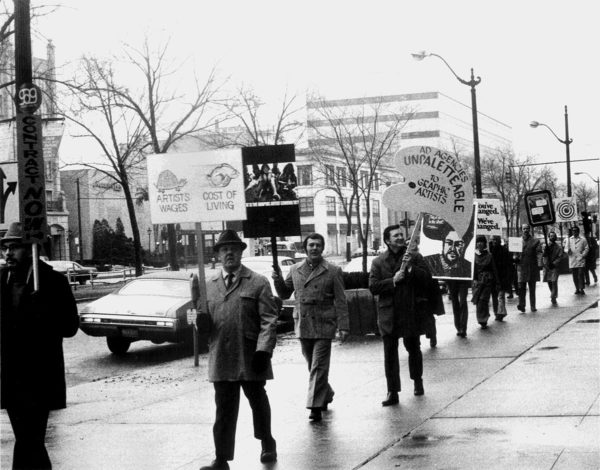
Organizing of Guild chapters initiated in Cleveland, Chicago, New York, and San Francisco.
First issue of a Graphic Artists Guild newsletter, To Date, published in February 1968.
First annual Guild Art Show in Detroit.
Independent national Guild and local Guild branch (chapter) organized in Detroit, with 113 initial members who signed the charter on November 2, 1967. Graphic Artists Guild Constitution patterned after that of the Screen Actors Guild.